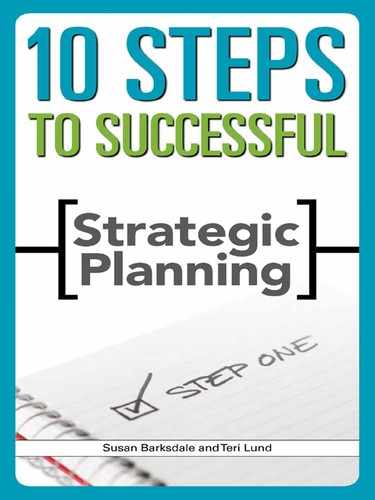PREFACE
Most successful organizations practice strategic planning. These organizations benefit not only from having a plan, but also from the planning process itself. The plan is the road map to success, and the planning process unites organizational leadership and enhances the communicating of critical company information. Today's volatile marketplace demands that employees, work groups, and organizations have a clear understanding of their roles, the products and services they offer, and the processes they use to navigate the continually changing waters they sail. A strategic plan that is directly related to group and individual planning provides an opportunity to create an outcome-based organization culture.
In the face of rapid change, organizations have realized they cannot compete on a global basis without a strategic plan that encourages innovation and creates knowledge internally and that builds customer loyalty to their products and services. A strategic plan provides the path an organization will take in the future (whether it will stay on course or follow a different direction than in the past); the predictions of how the marketplace, customer base, and product line will change or react to the future; and the calculated risk that the organization will need to bear to move in that direction. During strategic planning, organizations set their priorities for the next two to five years and identify how major resources will be allocated. If done correctly, the strategic plan should be a document that motivates employees to achieve the plan's stated goals and tactics. When realignment or redirection takes place, it is the strategic plan that explains the change in direction and refocuses the organization's efforts by redefining the organizational goals and major tactics.
But how do you develop a successful plan? The 10 Steps to Successful Strategic Planning is process driven and comprises the following 10 steps:
1. laying the foundation for the plan
2. scanning the business environment
3. collecting relevant data
4. analyzing collected data
5. stating mission, vision, and values
6. prioritizing needs and identifying risks
7. designing and validating tactics
8. prioritizing tactics and resources
9. documenting and communicating the plan
10. maintaining the plan.
Strategic planning provides a plethora of opportunities for an organization, such as facilitating discussion and analysis of past performance using a methodical approach, providing a method to prioritize performance needs and organization goals, supplying information that will assist in prioritizing resources, and enabling the organization to be proactive rather than reactive and therefore more in control. Developing a plan will enable your organization to
![]() ensure the products and services delivered to its customer base are consistent and of high quality
ensure the products and services delivered to its customer base are consistent and of high quality
![]() appraise past performance and identify successes and areas for future improvement
appraise past performance and identify successes and areas for future improvement
![]() create a consistent, sharp marketing message that promotes realistic expectations about the organization
create a consistent, sharp marketing message that promotes realistic expectations about the organization
![]() promote better use of resources (people, things, time, and finances)
promote better use of resources (people, things, time, and finances)
![]() manage customer expectations
manage customer expectations
![]() limit resource investment in activities that do not provide results
limit resource investment in activities that do not provide results
![]() encourage individuals to be more proactive and resourceful in problem solving through understanding how the strategy affects their responsibilities and accountabilities
encourage individuals to be more proactive and resourceful in problem solving through understanding how the strategy affects their responsibilities and accountabilities
![]() resolve internal performance problems by clarifying expectations and standardizing performance
resolve internal performance problems by clarifying expectations and standardizing performance
![]() strengthen its culture by motivating employees to embrace professional ethics and practices.
strengthen its culture by motivating employees to embrace professional ethics and practices.
The uses of a strategic plan vary as much as one organization varies from another. Organizations use strategic plans to direct business planning, to allocate funding during budgeting, to communicate with employees, to form the basis for new-employee orientation materials, and to aid individual performance planning, among many other uses. Because a strategic plan is the foundation for the organization's future it should be used for organizational performance planning and evaluation, goal setting and assessment, communication, and financial planning.
10 Steps to Successful Strategic Planning is part of the 10-Step Series and was written to provide you with a proven process and tool set to create a strategic plan. We hope that the tools contained in this book will guide you each step of the way in building a successful strategy. As you implement the strategic plan, you and your organization will continue to benefit from your strategic thinking.
Susan Barksdale and Teri Lund
November 2006
